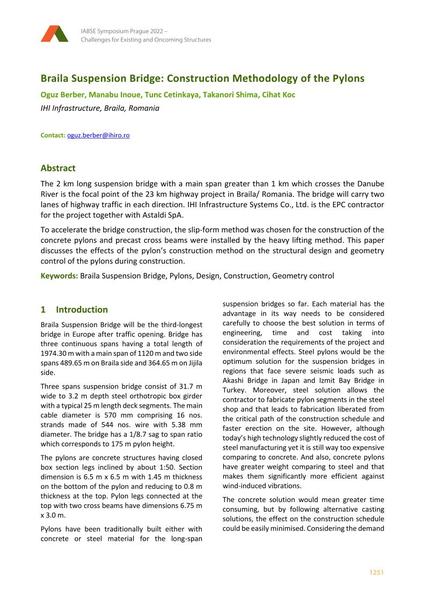Braila Suspension Bridge: Construction Methodology of the Pylons

|
|
|||||||||||
Bibliographic Details
| Author(s): |
Oguz Berber
(IHI Infrastructure, Braila, Romania)
Manabu Inoue (IHI Infrastructure, Braila, Romania) Tunc Cetinkaya (IHI Infrastructure, Braila, Romania) Takanori Shima (IHI Infrastructure, Braila, Romania) Cihat Koc (IHI Infrastructure, Braila, Romania) |
||||
|---|---|---|---|---|---|
| Medium: | conference paper | ||||
| Language(s): | English | ||||
| Conference: | IABSE Symposium: Challenges for Existing and Oncoming Structures, Prague, Czech Republic, 25-27 May 2022 | ||||
| Published in: | IABSE Symposium Prague 2022 | ||||
|
|||||
| Page(s): | 1251-1256 | ||||
| Total no. of pages: | 6 | ||||
| DOI: | 10.2749/prague.2022.1251 | ||||
| Abstract: |
The 2 km long suspension bridge with a main span greater than 1 km which crosses the Danube River is the focal point of the 23 km highway project in Braila/ Romania. The bridge will carry two lanes of highway traffic in each direction. IHI Infrastructure Systems Co., Ltd. is the EPC contractor for the project together with Astaldi SpA. To accelerate the bridge construction, the slip-form method was chosen for the construction of the concrete pylons and precast cross beams were installed by the heavy lifting method. This paper discusses the effects of the pylon’s construction method on the structural design and geometry control of the pylons during construction. |
||||
| Keywords: |
design pylons construction geometry control Braila Suspension Bridge
|
||||
| Copyright: | © 2022 International Association for Bridge and Structural Engineering (IABSE) | ||||
| License: | This creative work is copyrighted material and may not be used without explicit approval by the author and/or copyright owner. |
||||
